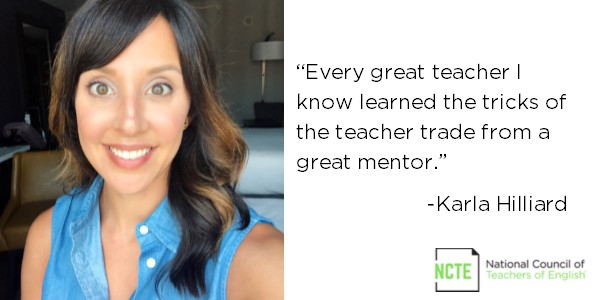This post is written by member Karla Hilliard.
The breadth of a great mentor’s influence is immeasurable.
First there was Chuck Malone, our lead teacher and Obi-Wan. Chuck’s wisdom, wit, and intellect made him a mentor for the ages. Once during my first year of teaching, I tearfully entered Chuck’s office to say, “Ok, I taught my first novel. Now what?” Chuck was the calm blue sea in the turbulent waves of my first year in the classroom. His patience with a panicked first-year teacher deserves an award.
Then, there was Mr. Mooney, an intellectual, in-the-trenches teacher, who walked me under many, many conversational anvils. He questioned me, challenged me, and prodded me to explain my lessons, my reasoning, and my points of view. It was enlightening and it was annoying, and I couldn’t help but to become deeply reflective. Mooney was the best teacher I knew, so I emulated him, and I became an infinitely stronger, more intentional teacher because of him.
Later, there was Liz, a friend and colleague, someone I learned with and from. In our years of teaching together, it was our job to make meaning out of the reds, yellows, and greens of state assessments. We kept one another sane in the sea of spreadsheets and mandated “data driven instruction,” and we reminded one another that our students were not graphs and numbers, but the kids we loved.
And a few years ago, I met Jess, an amalgam of the best teacher mentors along the way. When we began teaching together, my own children were 4 and 2, and juggling my tiny tots and a demanding career was wearing me down. She said something I’ll never forget: “Our children watch us. We are showing them that we can make the world a better place.” Four years later, Jess and I have re-established the state affiliate for West Virginia, WVCTE, and my now 8-year-old says she wants to be just like me when she grows up. Jess was right. Cue the water works.
But now, going into Year 13 of teaching, I find myself with the shoe on the other foot. I teach in our school’s new STEAM Academy, and last summer three other teachers and I were tasked with building and implementing this academy by taking 80 students, our 4 classes of English, math, biology, and social studies, and preparing students for careers or education in STEAM fields.
I admit that when I realized that I’d been teaching for more years than my three colleagues combined, I was nervous. And it wasn’t because they lacked intelligence or charisma or empathy. They don’t—they’re awesome. I was nervous because I was suddenly in a new role—one that I hadn’t expected—that of the mentor, the sensei, the Obi-Wan.
We four STEAM Academy teachers were practically strangers, but I knew that if we were going to build this thing and build it right, we also needed to build a strong collaborative team and mindset.
But true collaboration doesn’t happen overnight. It takes patience and time, deep reflection, and consideration. It takes building something important together and sharing our lives with one another. It takes dealing with our problems and issues by being open, honest, and transparent. It requires commitment and purpose, and most importantly, it requires strong relationships with one another. To do all of this, I knew, would require mentoring. And what I learned last year as we worked together to build this academy is that to be a mentor I had to …
Be a friend. Just like in our classrooms, we must grow authentic relationships built upon trust and mutual respect. I needed to listen, to share, to laugh, and to be open with my colleagues.
Ask questions. We ask our students deep, probing questions to lead them to their own insights and understandings. When my colleagues sought out my help or opinion, I tried to do what was done for me—to ask questions like, “Why did you select this [text/activity/assessment]? What do you want your students to learn from this? How do you imagine this playing out? Why is this lesson important?” Asking questions helped my colleagues and I have a conversation instead of a “class.”
Model and share. Sometimes our students need to see us think through a task or hear how we might approach a tricky piece of poetry. Colleagues who turn to us for guidance need to see effective teacher habits modeled and learn how we approach a difficult student, design a lesson or activity, put up with the paperwork, or create community and inspire ownership in our classrooms. By modeling and sharing openly with our colleagues, we can all learn a little something.
Every great teacher I know learned the tricks of the teacher trade from a great mentor. Those of us lucky enough to have been mentored have had the opportunity to listen, reflect, and refine—to transform our practice and improve our craft. I owe it to my colleagues who are looking for guidance to pass along what wisdom I’ve collected over the years, and I owe it to myself and my students to continue to be mentored by the great teachers around me.
Karla Hilliard teaches STEAM Academy Honors English 10 and AP Literature and Composition in Berkeley County, West Virginia. She is the executive vice president of the West Virginia Council of Teachers of English. Connect with me on Twitter at @karlahilliard!

